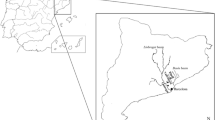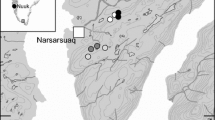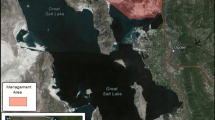Abstract
Water availability, which enables plant growth and animal activity, regulates dryland ecosystem function. In hyper-arid ecosystems, rain cannot support vascular plant growth. Therefore, hyper-arid vegetation is restricted to the lower topography, where runoff accumulates. Typically, food resources originating from areas of dense vegetation are dispersed across the desert floor, enabling animal life in areas lacking vascular plant growth. However, certain regions, such as the hyper-arid upper topography, may be devoid of plant-derived food resources. The present study examined arthropod activity in the upper topography of a hyper-arid desert, in comparison with arthropod activity in the lower topography. Pitfall traps were utilized to compare arthropod activity along unvegetated ridges with activity in parallel, vegetated riverbeds. Surprisingly, the study revealed dense arthropod communities in the barren upper topography. Arthropods collected in the upper topography represented 26% of total arthropod abundance. In addition, the overlap between arthropod identity in the ridges and wadis (i.e., riverbeds) was low, and certain arthropods were strongly affiliated with the ridges. The upper topographic communities included high numbers of silverfish (Zygentoma: Lepismatidae), malachite beetles (Psiloderes), and predatory mites (Acari: Anystidae), and these arthropods were present at various life stages. It remains unclear how arthropod communities can persist in the unvegetated upper topography of the hyper-arid study area. These results raise the possibility that other food sources, independent from vascular plants, may play a significant role in the life history of hyper-arid arthropods.
Similar content being viewed by others
References
Abd El-Ghani M M, Amer W M. 2003. Soil-vegetation relationships in a coastal desert plain of southern Sinai, Egypt. Journal of Arid Environments, 55(4): 607–628.
Alatawi A S, Gilbert F, Reader T. 2020. Modelling terrestrial reptile species richness, distributions and habitat suitability in Saudi Arabia. Journal of Arid Environments, 178: 104153.
Barrow C J. 1992. World Atlas of Desertification, Vol. 80. UNEP and E. Arnold Ltd., Kent: Land Degradation and Development, 3: 249–249.
Bird T, Bouskila A, Groner E, et al. 2020. Can vegetation removal successfully restore coastal dune biodiversity across multiple taxa? Applied Sciences, 10: 2310.
Bregović P, Zagmajster M. 2016. Understanding hotspots within a global hotspot-identifying the drivers of regional species richness patterns in terrestrial subterranean habitats. Insect Conservation and Diversity, 9(4): 268–281.
Cammeraat L H. 2002. A review of two strongly contrasting geomorphological systems within the context of scale. Earth Surface Processes and Landforms, 27(11): 1201–1222.
Crawford C S, Taylor E C. 1984. Decomposition in arid environments: role of the detritivore gut. South African Journal of Science, 80(4): 170.
Dean W R J, Milton S J, Jeltsch F. 1999. Large trees, fertile islands, and birds in arid savanna. Journal of Arid Environments, 41(1): 61–78.
di Giovanni E, Palombini A. 2002. Desertification, Sustainability, and Archaeology: Indications from the Past for an African Future. In: Bonsignori Editore. Origins: Prehistory and Protohistory of Ancient Civilizations. Italia: Universita di Roma, 303–334. (Italiano)
El-Bana M I, Al-Mathnani A. 2009. Vegetation-soil relationships in the wadi Al-Hayat area of the Libyan Sahara. Australian Journal of Basic and Applied Sciences, 3(2): 740–747.
Fossati J, Pautou G, Peltier J P. 1999. Water as resource and disturbance for wadis vegetation in a hyperarid area (Wadi Sannur, Eastern Desert, Egypt). Journal of Arid Environments, 43(1): 63–77.
Furniss R L, Carolin V M. 1977. Western forest insects (No. 1339). US Department of Agriculture, Forest Service. doi: https://doi.org/10.5962/bhl.title.131875
Ginat H, Shlomi Y, Batarseh S, et al. 2011. Reduction in precipitation levels in the Arava Valley (southern Israel and Jordan), 1949–2009. Jounal of Dead-Sea Arava Research, 1: 1–7.
Giorgi F, Hewitson B, Arritt R, et al. 2001. Regional Climate Information-Evaluation and Projections. Iowa State University: Geological and Atmospheric Sciences Publications, 110.
Goldreich Y, Karni O. 2001. Climate and precipitation regime in the Arava Valley, Israel. Israel Journal of Earth Sciences, 50(2): 53–59.
Hackett T D, Korine C, Holderied M W. 2013. The importance of acacia trees for insectivorous bats and arthropods in the Arava Desert. PloS ONE, 8(2): e5299.
Holtgrieve G W, Schindler D E, Jewett P K. 2009. Large predators and biogeochemical hotspots: brown bear (Ursus arctos) predation on salmon alters nitrogen cycling in riparian soils. Ecological Research, 24(5): 1125–1135.
IPCC (Intergovernmental Panel on Climate Change). 2007. Climate Change 2007: Synthesis Report-Summary for Decision Makers. IPCC Fourth Assessment Report, 22.
Kassas M, Girgis W. 1965. Habitat and plant communities in the Egyptian desert: VI. The units of a desert ecosystem. Journal of Ecology, 53(3): 715–728.
Kremen C, Colwell R K, Erwin T L, et al. 1993. Terrestrial arthropod assemblages: their use in conservation planning. Conservation Biology, 7(4): 796–808.
Lalley J, Viles H A, Henschel J, et al. 2006. Lichen-dominated soil crusts as arthropod habitat in warm deserts. Journal of Arid Environments, 67(4): 579–593.
Liu R, Zhu F, Steinberger Y. 2016. Changes in ground-dwelling arthropod diversity related to the proximity of shrub cover in a desertified system. Journal of Arid Environments, 124: 172–179. doi: https://doi.org/10.1016/j.jaridenv.2015.08.014.
Louw G N, Hamilton W J. 1972. Physiological and behavioural ecology of the ultrapsammophilous Namib Desert tenebrionid, Lepidochora argentogrisea. Madoqua, 2(1): 87–95.
Mayor Á G, Bautista S, Small E E, et al. 2008. Measurement of the connectivity of runoff source areas as determined by vegetation pattern and topography: A tool for assessing potential water and soil losses in drylands. Water Resources Research, 44(10): https://doi.org/10.1029/2007WR006367.
Meserve P L, Glanz W E. 1978. Geographical ecology of small mammals in the northern Chilean arid zone. Journal of Biogeography, 5(2): 135–148.
Monod T. 1954. Contracted and diffuse modes of Saharan vegetation. In: Cloudsley-Thompson J L. Biology of Deserts. London: Institute of Biology, 35–44.
Nawaz M A, Rafique M, Khan N K. 2011. Pattern of mammalian distribution in the Chagai Desert, Balochistan, Pakistan. Pakistan Journal of Zoology, 43(5): 841–847.
Noy-Meir I. 1973. Desert ecosystems: environment and producers. Annual Revision of Ecological Systems, 4(1): 25–51.
Parker W S, Pianka E R. 1975. Comparative ecology of populations of the lizard Uta stansburiana. Copeia, 4: 615–632.
Pointing S B, Belnap J. 2012. Microbial colonization and controls in dryland systems. Nature Reviews Microbiology, 10(8): 551–562.
Pueyo Y, Moret-Fernández D, Saiz H, et al. 2013. Relationships between plant spatial patterns, water infiltration capacity, and plant community composition in semi-arid Mediterranean ecosystems along stress gradients. Ecosystems, 16(3): 452–466.
Rebelo H, Brito J C. 2007. Bat guild structure and habitat use in the Sahara Desert. African Journal of Ecology, 45(2): 228–230.
Rubinstein Y, Groner E, Yizhaq H, et al. 2013. An eco-spatial index for evaluating stabilization state of sand dunes. Aeolian Research, 9: 75–87.
Ruhm J, Böhnert T, Weigend M, et al. 2020. Plant life at the dry limit-spatial patterns of floristic diversity and composition around the hyperarid core of the Atacama Desert. PloS ONE, 15(5): e0233729.
Schwinning S, Sala O E, Loik M E, et al. 2004. Thresholds, memory and seasonality: understanding pulse dynamics in arid/semi-arid ecosystems. Oecologia, 141: 191–193.
Shachak M, Jones C G, Granot Y. 1987. Herbivory in rocks and the weathering of a desert. Science, 236(4805): 1098–1099.
Swift M J, Heal O W, Anderson J M, et al. 1979. Decomposition in terrestrial ecosystems. The Quarterly Review of Biology, 56: 96.
ter Braak C J F, Smilauer P. 2015. CANOCO Reference Manual and CanoDraw for Windows User’s Guide: Software for Canonical Community Ordination (version.5.0). Microcomputer Power, Itaca.
Trenberth K E. 2011. Changes in precipitation with climate change. Climate Research, 47: 123–138.
Valavanis V D, Kapantagakis A, Katara I, et al. 2004. Critical regions: a GIS-based model of marine productivity hotspots. Aquatic sciences, 66(1): 139–148.
Ward D. 2009. The Biology of Deserts. New York: Oxford University Press, 304.
Ward D F, Stanley M C. 2004. The value of RTUs and parataxonomy versus taxonomic species. New Zealand Entomologist 27(1): 3–9.
Warren-Rhodes K A, Rhodes K L, Pointing S B, et al. 2006. Hypolithic cyanobacteria, dry limit of photosynthesis, and microbial ecology in the hyperarid Atacama Desert. Microbial Ecology, 52: 389–398.
Watson R T. 1989. Niche separation in Namib Desert dune Lepismatidae (Thysanura, Insecta): detritivores in an allochthonous detritus ecosystem. Journal of Arid Environments, 17(1): 37–48.
Wessels D C J, Wessels L A, Holzapfel W H. 1979. Preliminary report on lichen-feeding Coleoptera occurring on Teloschistes capensis in the Namib Desert, South West Africa. Bryologist, 82(2): 270–273.
White R P, Nackoney J. 2003. Drylands, people, and ecosystem goods and services: a web-based geospatial analysis. World Resources Institute.
Zohary M. 1962. Plant Life of Palestine: Israel and Jordan. New York: Ronald Press, 393–394.
Acknowledgements
Special thanks to Ms. Amelia LIBERATORE for her counsel throughout the project and assistance in the field, Mr. Shmuel BERMAN for his knowledge of local topography, Mr. Gabriele FRANZINI for his expertise in Melyrid beetles, and Dr. Jawad HASAN-SHOQEIR for his ongoing support throughout the project. Ms. Elli GRONER is supported by the Ministry of Science and Technology. We also thank Ms. Michelle FINZI for reviewing and editing this paper.
Author information
Authors and Affiliations
Corresponding author
Rights and permissions
About this article
Cite this article
Davidson, B., Groner, E. An arthropod community beyond the dry limit of plant life. J. Arid Land 13, 629–638 (2021). https://doi.org/10.1007/s40333-021-0009-1
Received:
Revised:
Accepted:
Published:
Issue Date:
DOI: https://doi.org/10.1007/s40333-021-0009-1




